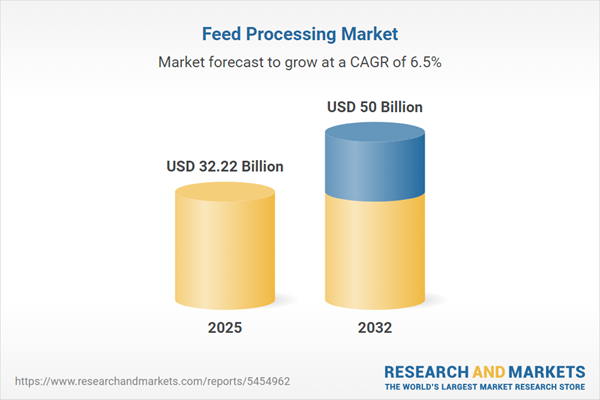Speak directly to the analyst to clarify any post sales queries you may have.
The feed processing market is undergoing strategic transformation as regulatory shifts, supply chain complexity, and ambitious sustainability goals converge. Senior decision-makers are challenged to develop proactive strategies that ensure compliance, operational resilience, and competitive positioning in a dynamic global landscape.
Market Snapshot: Feed Processing Market Size and Growth Outlook
The global feed processing market is projected to grow from USD 30.21 billion in 2024 to USD 32.22 billion in 2025, with a compound annual growth rate (CAGR) of 6.50%. Market growth is fueled by rising demand for animal protein, rapid uptake of digital technologies across manufacturing and logistics, and ongoing industry shifts towards greater digitalization and decarbonization in supply chains. Industry leaders are investing in advanced digital systems, transparent operational models, and product innovation to respond to regulatory change and sector-wide evolution. As food safety standards and animal nutrition requirements become increasingly stringent, end-to-end supply chain partners focused on efficiency, compliance, and transparent operations are earning higher levels of trust and attention.
Scope & Segmentation: Comprehensive Analysis of the Feed Processing Market
- Animal Type: Nutritional solutions target aquatic species, poultry, ruminants, swine, and companion animals. Market offerings allow operators to tailor nutrition programs to production livestock and pets, supporting health and productivity in a range of rearing systems.
- Feed Form: Product forms encompass extruded, liquid, meal, and pellet feeds. This segmentation delivers tailored nutrition, flexible production scheduling, and effective logistics options to suit varied operational needs and animal species.
- Feed Ingredient: Functional additives, circular economy byproducts, grain-based energy components, and oilseeds shape this segment. Ingredient selection drives sustainability in formulation, manages input costs, and enables innovation responsive to both regulatory requirements and evolving buyer preferences.
- Processing Technology: Core technologies include coating, extrusion, grinding, and pelleting. These processes uphold product safety, extend shelf-life, and enable scalable, adaptable manufacturing according to local infrastructure and compliance standards.
- Production Method: The market spans both traditional and organic feed manufacturing. A growing focus on premium and sustainable nutrition is guided by regulatory transitions as well as market interest in traceable product origins and elevated animal welfare.
- Regional Focus: The Americas, Europe, Middle East and Africa, and Asia-Pacific each display distinct regulatory pressures, adoption rates for advanced technologies, and specific customer priorities. These dynamics shape strategy, making regional tailoring essential for innovation and compliance.
- Company Profiles: Leaders such as Bühler AG, ANDRITZ AG, California Pellet Mill Co., and Wenger Manufacturing are highlighted for adaptive operational strategies that address regulatory complexity, efficiency needs, and differentiated market positioning in feed supply chains.
Key Takeaways for Senior Decision-Makers in Feed Processing
- Processed feed solutions enhance transparency and systematically support sustainability commitments and compliance in global supply chains subject to varied regulation.
- Digital transformation increases visibility and agility, enabling rapid organizational response to evolving policy, animal nutrition science, and shifting customer requirements.
- Continuous product and process innovation helps organizations adapt to input cost variance, ingredient availability, and advances in feed formulation science.
- Modern procurement models focus on building strong partnerships with regional and local suppliers to increase supply diversity, regulatory alignment, and logistics continuity through all stages.
- Investment in research and development extends the range of functional feed offerings, enhances market competitiveness, and supports entry into emerging nutrition categories.
Tariff Impact: Navigating the 2025 U.S. Tariff Regime
The forthcoming U.S. tariff regime for 2025 is intensifying feed processor cost structures. In this environment, companies are accelerating local sourcing and scaling domestic manufacturing to lower risk from ongoing global trade disruptions. By diversifying ingredient portfolios and implementing targeted investment in alternatives, market participants strengthen their resilience, reinforce supply continuity, and mitigate vulnerability to external economic pressures. These adaptive strategies support organizational stability within the evolving regulatory context.
Methodology & Data Sources
This analysis draws upon secondary market research, in-depth interviews with feed mill executives, and structured global surveys. Analytical frameworks such as SWOT and scenario mapping are used to ensure findings are relevant to the strategic priorities of executive and board-level leaders.
Why This Report Matters
- Provides benchmarking insights and strategic planning tools for capital allocation across the animal nutrition supply chain.
- Supports agile product development and supply chain management in alignment with regulatory, technological, and consumer market change.
- Delivers actionable recommendations and forward-looking guidance for addressing compliance, market evolution, and innovation challenges.
Conclusion
Using the report’s insights, executives can anticipate industry changes, align operational strategy, and maintain relevance within an evolving feed processing landscape. Adaptability and informed decision-making are vital for long-term organizational performance.
Additional Product Information:
- Purchase of this report includes 1 year online access with quarterly updates.
- This report can be updated on request. Please contact our Customer Experience team using the Ask a Question widget on our website.
Table of Contents
3. Executive Summary
4. Market Overview
7. Cumulative Impact of Artificial Intelligence 2025
Companies Mentioned
The companies profiled in this Feed Processing market report include:- Bühler AG
- ANDRITZ AG
- California Pellet Mill Co., Inc.
- Wenger Manufacturing, Inc.
- Amandus Kahl GmbH & Co. KG
- Satake Corporation
- Van Aarsen International B.V.
- Zhengchang Machinery Co., Ltd.
- Palamatic Process SA
- Petkus Technologie GmbH
Table Information
| Report Attribute | Details |
|---|---|
| No. of Pages | 199 |
| Published | November 2025 |
| Forecast Period | 2025 - 2032 |
| Estimated Market Value ( USD | $ 32.22 Billion |
| Forecasted Market Value ( USD | $ 50 Billion |
| Compound Annual Growth Rate | 6.5% |
| Regions Covered | Global |
| No. of Companies Mentioned | 11 |









